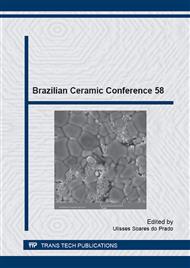p.503
p.509
p.515
p.520
p.526
p.535
p.539
p.545
p.549
Study of the Stabilization/Solidification of Oily Sludge of Oil through of Scanning Electron Microscopy and Diffraction of X-Rays
Abstract:
The objective of this study was to evaluate materials stabilized by solidification after incorporation of oily sludge of oil in a ordinary Portland cement matrix through analysis tests Scanning Electron Microscopy (SEM) and X-Ray Diffraction (XRD). The research was divided into two main stages. In the first step the preparation of the specimens composed of cement, sand and oily sludge of oil and the second step was to evaluate the stabilization/solidification material via SEM and XRD analysis. The results of the XRD identified the characteristic peaks of portlandite, calcium silicate and ettringite. The same occurred with the SEM that detected the presence of the main products of the reactions of cement hydration. The results showed that the oily sludge of oil did not interfere with cement hydration reactions.
Info:
Periodical:
Pages:
526-531
Citation:
Online since:
June 2015
Price:
Сopyright:
© 2015 Trans Tech Publications Ltd. All Rights Reserved
Share:
Citation:


